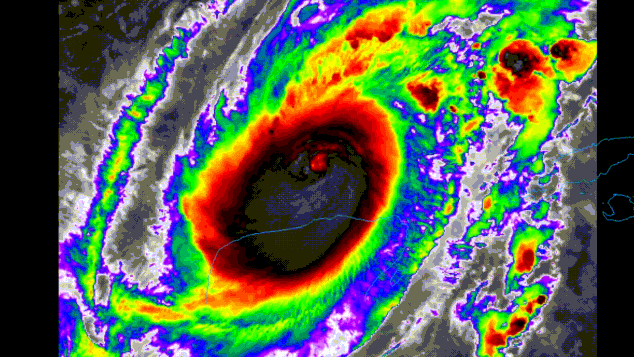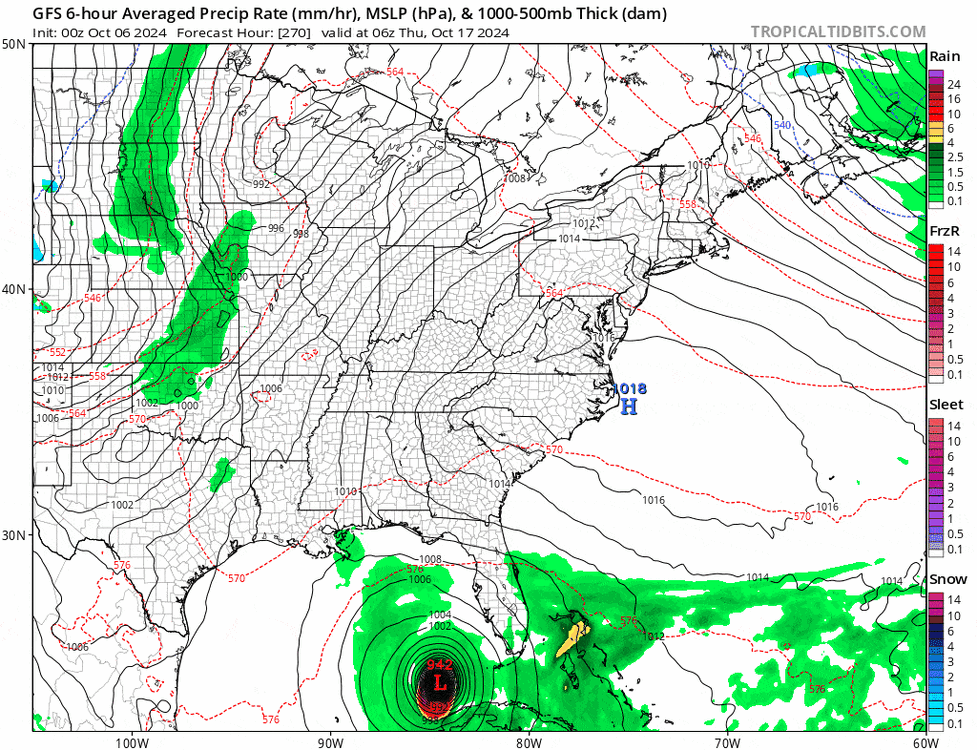-
Posts
6,319 -
Joined
-
Last visited
Content Type
Profiles
Blogs
Forums
American Weather
Media Demo
Store
Gallery
Posts posted by bobbutts
-
-
Heavy rain but not much lightning or wind in Bow.
-
Flipped to snow in the last 20 mins or so.
-
-
Rain here. Family came over from 10 mins away and reported 1/2" of slushy accumulation where they came from.
-
Had a few minutes of pea sized hail there. Just a bit of lighting.
-

that is a few blocks from the tdwr site! Crazy detail
-
 3
3
-
 1
1
-
-
1 minute ago, Cyclone-68 said:
Ugggh..Didn’t want to hear that. They just flat out refuse to go. It’s inexplicable
Sorry to hear that. Are they too young to remember Katrina? Maybe have them read up on that.
-
 2
2
-
-
7 minutes ago, Pityflakes said:
Yikes. I think this likely exceeds Charlie in the Port Charlotte/Punta Gorda area. May actually be the zone of highest realized surge.
It wouldn't take much to exceed Charley in surge for that area. It wasn't a factor. Milton is a lock to exceed the surge and unlikely reach the same type of wind damage in Port C/PG.
-
2 minutes ago, dbullsfan said:
Most consensus seems to think this turns east well before Tampa now. This line doesn’t seem likely at all.
.It is an extrapolation which ignores all other factors besides previous motion. Not intended to be a forecast.
-
 1
1
-
-
extrapolating the recent radar movement would bring it just up the north side of the bay

-
 1
1
-
-
6 minutes ago, schoeppeya said:
Those supercells that are offshore are going to be a really, really bad situation.
Pretty impressive radar image there

-
 1
1
-
-
Truck tire rolling down the gulf.
-
 1
1
-
 1
1
-
-

-
 10
10
-
 1
1
-
 1
1
-
-
Watching a potentially bad surge situation approach a large low elevation population give me Katrina vibes. Having lived in SW FL I know there plenty of stubborn and complacent people who will stay in risky areas too.
-
Quote
ESTIMATED MINIMUM CENTRAL PRESSURE 945 MB EYE DIAMETER 15 NM MAX SUSTAINED WINDS 110 KT WITH GUSTS TO 135 KT.
-
Quote
Hurricane Milton Discussion Number 6 NWS National Hurricane Center Miami FL AL142024 400 PM CDT Sun Oct 06 2024 Milton is rapidly intensifying. Satellite images indicate very deep convection in the eyewall and hints of an eye starting to appear. The last fix from the aircraft showed that the central pressure was down to 985 mb, about 3 mb less than 80 minutes prior, and winds supporting 70 kt at the surface. Since that time, satellite images continue to show further organization, and the initial wind speed is set to 75 kt. Milton is moving just south of due east at about 6 kt. This equatorward motion has been more than expected probably due to a stronger low/ mid-level frontal low over the northeastern Gulf of Mexico. The frontal feature is forecast to weaken while it moves across Florida and gradually lose its influence on Milton. This evolution should allow the hurricane to turn eastward on Monday and then accelerate to the northeast on Tuesday and Wednesday toward the Florida Peninsula ahead of a trough moving offshore of Texas. The NHC forecast is a bit south of the previous one through 48 hours, following the trend of the guidance at that time, and the government of Mexico has issued a Hurricane Watch for a portion of the northern coast of Yucatan. Later on, the guidance is similar to, or slightly north of the last cycle, and very little change is made to the forecast near Florida. It should be noted that the average NHC track error at day 3 is around 100 miles, and users should not focus on the exact track. The intensity forecast appears straightforward at first, with rapid intensification likely while the small hurricane remains within light shear and over very deep warm waters. Intensity guidance is about as bullish as I've seen in this part of the basin, with almost everything showing a peak intensity of category 4 or 5 in the southern Gulf of Mexico in a day or two. The NHC forecast is raised from the previous one and lies near the intensity consensus model and still could be too low. Later on, vertical wind shear is forecast to markedly increase as Milton approaches Florida, and some weakening is anticipated. However, the regional hurricane models are showing the system growing even if it weakens, and we are expecting Milton to be a large hurricane at landfall, with very dangerous impacts spread out over a big area. There is increasing confidence that a powerful hurricane with life- threatening hazards will be affecting portions of the Florida west coast around the middle of this week. Residents there should closely monitor this system and listen to local officials. Key Messages: 1. Milton is forecast to be a major hurricane when it reaches the west coast of the Florida Peninsula midweek. Users are reminded to not focus on the details of the forecast as there remains significant uncertainty in the eventual track and intensity of Milton. 2. While it is too soon to specify the exact magnitude and location of the greatest impacts, there is an increasing risk of life- threatening storm surge and damaging winds for portions of the west coast of the Florida Peninsula beginning early Wednesday and Storm Surge and Hurricane Watches will likely be issued tonight or early Monday. Residents in the Florida Peninsula should follow any advice given by local officials and monitor updates to the forecast. 3. Areas of heavy rainfall will impact portions of Florida through Monday well ahead of Milton, with heavy rainfall more directly related to Milton expected on Tuesday through Wednesday night. This rainfall will bring the risk of considerable flash, urban, and areal flooding, along with the potential for moderate to major river flooding. 4. Tropical storm conditions are expected with hurricane conditions possible beginning Monday across portions of the northern Yucatan Peninsula of Mexico where a Tropical Storm Warning and Hurricane Watch are in effect. FORECAST POSITIONS AND MAX WINDS INIT 06/2100Z 22.4N 93.8W 75 KT 85 MPH 12H 07/0600Z 22.2N 92.6W 90 KT 105 MPH 24H 07/1800Z 22.2N 90.9W 110 KT 125 MPH 36H 08/0600Z 22.6N 89.0W 120 KT 140 MPH 48H 08/1800Z 23.6N 86.9W 125 KT 145 MPH 60H 09/0600Z 25.2N 85.1W 120 KT 140 MPH 72H 09/1800Z 27.0N 83.1W 105 KT 120 MPH 96H 10/1800Z 29.8N 77.5W 65 KT 75 MPH...POST-TROP/EXTRATROP 120H 11/1800Z 31.4N 68.8W 55 KT 65 MPH...POST-TROP/EXTRATROP
-
-
19 minutes ago, cptcatz said:
This is ridiculous to say. First of all, Milton seems to have a higher ceiling with multiple models showing possible cat 5. Even if it weakens before landfall the surge will still be there (see Katrina). Second, Helene's surge was over swamp land of the big bend while Miltons will be over developed beachfront properties. Third, even if it hits south of Tampa and spares Tampa Bay, that likely means Fort Myers gets the worst of it which is just now starting to bounce back from Ian. So basically it's a tossup between surge destruction in Tampa Bay or in Fort Myers, either of them will be bad.
To add to your point. Looking at a satellite map should help people who aren't familiar with the area. From the Tampa Bay area and south there is nearly continuous development in potential surge areas right up to the gulf and extensive bays and canals and low lying areas. To the north there's very little development right on the coast.
-
 1
1
-
-
15 hours ago, LeesburgWx said:
I was thinking of Hurricane Charley and how that hurricane veered NE before reaching Tampa. Everyone was very worried for Tampa Bay but I have to imagine, the trajectory for Milton vs Charley is much worse, if Milton comes ashore at or just north of Tampa Bay.
Charley was running at almost a parallel angle to the FL coast and was a tiny storm with a small patch of major wind damage well inland and relatively limited storm surge. We'll have to watch the details on this but it appears to have greater potential for surge based at this point based on likely storm strength/size and approach angle/speed.
-
Not many outs on that forecast cone.
-
Not many October historical tracks like the eps there.. Closest I found was Cat 1 Unnamed Oct 24, 1859 to Oct 29, 1859. Cat 2 Unnamed Oct 08, 1888 to Oct 12, 1888 looks similar too.
Assuming my search is correct there hasn't been a hurricane that originated in the Gulf and struck within 150mi of Sarasota since that storm in 1888. Not implying any forecast with that tidbit, just find it interesting.
-
We obsess over wind but loss of life is usually the result of flooding.
-
 2
2
-
 1
1
-
 4
4
-
-
Cell by Alton shows 3.5" hail icon on grlevel3. About as large as I can remember seeing. Wonder what size is reaching the ground?
QuoteAt 718 PM EDT, a severe thunderstorm was located near Alton, or 14
miles southeast of Laconia, moving east at 40 mph.HAZARD...Ping pong ball size hail and 60 mph wind gusts.
-
 2
2
-
-
Rain and a bunch of rumbling here but winds stayed pretty light. Doubt it got over 30mph.
-
 1
1
-




July 2025 Obs/Disco ... possible historic month for heat
in New England
Posted
Looks like some large hail with that storm. 2.75" according to grlevelx (I'm ignorant of how that is actually calculated)